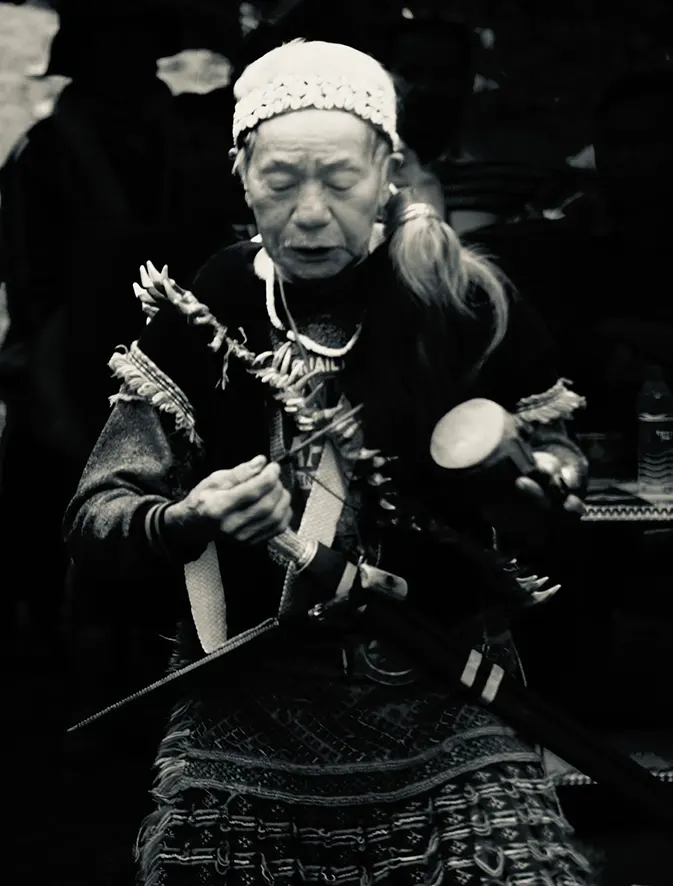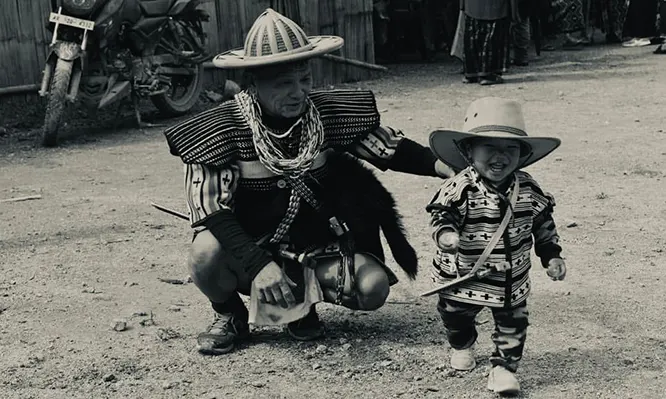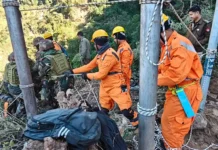[Apasi Linggi]
In a quiet room, an elder chants in Idu Mishmi, the words flowing like the rivers they revere. The children watch, silent and curious, but unable to repeat the phrases.
The elder’s solemn voice is a reminder of how fragile a language can be when it is no longer spoken by the younger generation. This is how it fades, he murmurs, underlining the urgent need to preserve this living heritage.
As an Idu Mishmi, I deeply feel the weight of my community standing at a critical juncture. Our ancient practices, particularly shamanism, embodied by the igu – our traditional shamans – along with our language face growing threats from modernity.
Both of these cultural pillars are essential to our identity, and their preservation has become a matter of urgency for us all. For generations, the igus have been the guardians of our traditions. They have not only acted as spiritual mediators but also as the keepers of our history, weaving our collective myths, ethics, and customs into their chants and rituals.
However, according to a database created by the Identification, Preservation and Documentation of Institution of Igu (IPD-Igu) – a sub-committee of the Idu Mishmi Cultural and Literary Society (IMCLS) – the number of practicing igus has sharply declined, from 81 in 2021 to just 67 now. This decline can be attributed to several factors, including the rise of organised religions, the allure of modern lifestyle, and a lack of support for traditional practices. This shrinking number of igus has created a situation where fewer people have access to the sacred knowledge and rituals that have defined us for centuries.
Growing up, I noticed a gap between my siblings and I, and our traditional tongue, as Hindi and English became the languages of communication. I wasn’t fluent in Idu Mishmi, and many others are in the same position. This disconnection from our mother language has become a widespread trend which threatens the survival of our linguistic heritage.
The preservation of the Idu Mishmi language is a race against time, and various organisations are stepping up to keep it alive. When I spoke with Kombong Darang, research officer at the RIWATCH Centre for Mother Languages (RCML), his professionalism shone through as he shared the role of the centre in preserving the Idu Mishmi language. While driven by the responsibility of his position, he emphasised the importance of daily language use in keeping it alive.
 “Documenting the language is time-consuming, but it’s crucial for ensuring that future generations can access their cultural roots,” he explained. His work at the RIWATCH focuses on documenting oral traditions, an essential task for communities without a written script. Darang’s work at the RIWATCH primarily involves documenting the oral traditions of Arunachal Pradesh’ tribal communities, including the Idu Mishmis. “Given that many communities lack a written script, we focus on audiovisual documentation to preserve their oral knowledge,” he explained. Through initiatives like creating pictorial glossaries for children and publishing books on folktales and folksongs, the RIWATCH collaborates closely with local communities to ensure authenticity and relevance.
“Documenting the language is time-consuming, but it’s crucial for ensuring that future generations can access their cultural roots,” he explained. His work at the RIWATCH focuses on documenting oral traditions, an essential task for communities without a written script. Darang’s work at the RIWATCH primarily involves documenting the oral traditions of Arunachal Pradesh’ tribal communities, including the Idu Mishmis. “Given that many communities lack a written script, we focus on audiovisual documentation to preserve their oral knowledge,” he explained. Through initiatives like creating pictorial glossaries for children and publishing books on folktales and folksongs, the RIWATCH collaborates closely with local communities to ensure authenticity and relevance.
Despite these efforts, challenges persist. “Documenting folksongs and folktales is time-consuming and requires immense patience,” Darang said. “Finding fluent speakers is also a significant obstacle.” However, the RIWATCH employs meticulous methods, engaging multiple speakers to verify the accuracy of linguistic data.
A particularly pressing concern is the documentation of the language used by the igus (shamans), whose rituals and vocabulary are critically endangered. While the RIWATCH has not yet recorded igu-led rituals, Darang emphasised the need to prioritise this area in the future. “The language of the igus holds immense cultural and spiritual value. Its preservation is crucial,” he said.
The government’s role in these efforts is also significant, but Darang stressed that communities must take ownership of their languages. “The government is doing its part, but whether it’s enough is uncertain. Ultimately, communities bear the responsibility to promote their language,” he remarked. Reflecting on his time working in the RIWATCH, Darang shared a hopeful vision: “The Idu community possesses immense cultural, traditional, and linguistic richness. Their rituals and practices remain authentically preserved. Now is the ideal time to document their traditional knowledge and raise awareness about preserving their cultural heritage.”
This sentiment is echoed by Sapna Linggi, who serves as a field coordinator-cum-research assistant at the RIWATCH and is also a member of the Idu Mishmi community. Her personal journey of acknowledging and appreciating the cultural importance of her own language underscores the urgency of this mission. “I have never really spoken my own mother tongue my whole life,” she confessed. “It is a person’s root, a strong identity to define who they really are, and I shamefully must say, I have lost it. This feeling inside me is what drove me to work for the preservation and promotion of our mother languages.”
Through her work, she is helping to promote the Idu Mishmi language, ensuring that future generations will have access to this vital cultural resource. “Though I might not be fluent now, I have learned a lot, and I am happy to say I am catching up with my mother tongue,” Sapna said, speaking of her personal growth through this work. Reflecting on her work, Sapna shared the importance of community participation in language preservation. “I really hope that parents, teachers, and students who are native speakers try harder to keep speaking the mother dialect,” she said. She believes that the community must collaborate with organisations like the RIWATCH to ensure that their linguistic heritage is preserved for future generations.
In addition to the efforts of the RIWATCH, the Idu Mishmi community has a key ally in the Idu Mishmi Cultural and Literary Society (IMCLS). Under the leadership of Ginko Lingi (president) and Rao Dele (secretary), the IMCLS has taken significant strides toward preserving the Idu Mishmi language and culture. The organization has formed a specialised committee – the Idu Mishmi Cultural and Literary Society’s Committee on Identification, Preservation, and Documentation of Institution of Igu/Shaman (IPD-IGU, IMCLS). This committee aims to address the critical issue of the dwindling number of igus and preserve the sacred rituals and knowledge associated with the position.
Even in schools, efforts to integrate the Idu language remain limited. While a few institutions have introduced Idu as part of their curriculum, it is far from widespread. Among these, only one or two schools have been observed to consistently implement the use of the Idu language as a third language in their institution.
At the community level, efforts by the All Idu Mishmi Students Union (AIMSU), in collaboration with the Information Preservation and Documentation (IPD) of Igus, and the RIWATCH Centre for Mother Language (RCML), the Dibang Valley District Students’ Union organises workshops and programmes like Idu Mishmi language promotion programme and Igu tamro workshops.
AIMSU president Drone Linggi acknowledged this gap of short-term programmes often failing to ignite a long-lasting interest among the youths and said, “Workshops last only three or four days. We are planning to implement long-term goals for this.”
Prominent igu Sipa Melo teaches young and enthusiastic people the art of shamanism under the Idu Mishmi Shaman Fellowship Programme at the Igu Training Centre in Alinye in Dibang Valley district. He expressed concern over the dwindling number of shamans and very poor participation of the youths. “In the past, shamans were chosen by divine forces, often through specific signs or experiences such as recurring dreams, visions, or unexplained illnesses. Now, with so few left, we are urging the younger generation to step up and learn,” he said.
Despite his and the committee’s dedication, only a handful of youths have shown interest.
However, despite these commendable efforts, a challenge remains: the younger, educated generation tends to shy away from pursuing a career as an igu, favouring more stable and financially rewarding professions. Parents, too, often discourage their children from following in the footsteps of their ancestors. Becoming an igu is a lifelong commitment; once someone assumes the role, they cannot simply return to normal life unless they convert to another religion. This societal structure and the dwindling number of aspiring shamans put the cultural preservation of the Idu Mishmi community at a significant risk.
The collective efforts of organisations like the RIWATCH, the IMCLS, and the AIMSU shows that, while challenges remain, there is still hope for the preservation of the Idu Mishmi language and culture. Language preservation is not merely about saving words – it’s about sustaining the soul of a culture, ensuring that the whispers of today can become the songs of tomorrow.


